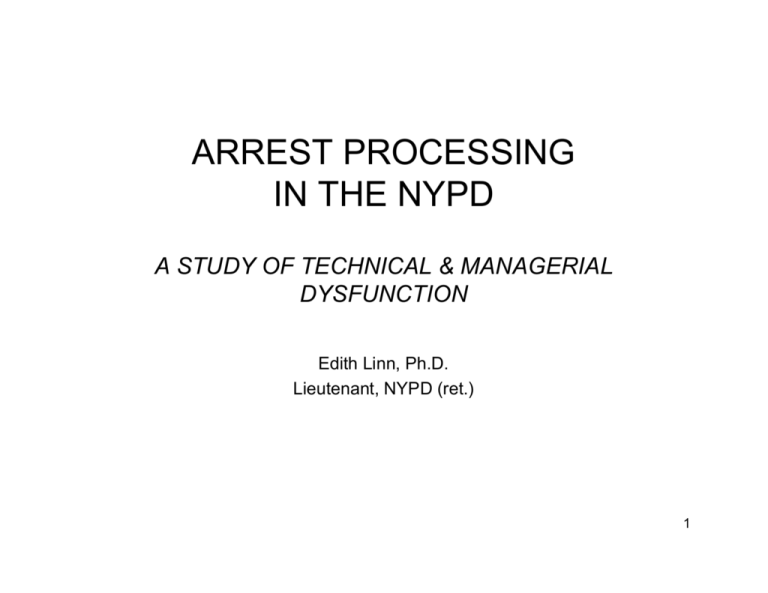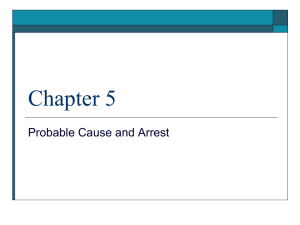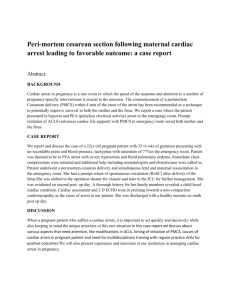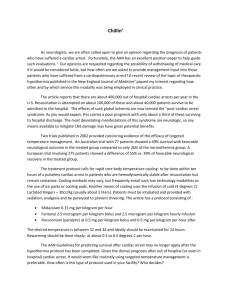ARREST PROCESSING IN THE NYPD A STUDY OF TECHNICAL
advertisement

ARREST PROCESSING IN THE NYPD A STUDY OF TECHNICAL & MANAGERIAL DYSFUNCTION Edith Linn, Ph.D. Lieutenant, NYPD (ret.) 1 NYPD ARREST PROCESSING: A TEN-HOUR ORDEAL I. WHY DO ARRESTS TAKE SO LONG TO PROCESS? II. HOW DOES THIS LONG, ARDUOUS PROCESS AFFECT OFFICER BEHAVIOR? III. HOW CAN TECHNOLOGY HELP? 2 INSPIRATION FOR RESEARCH 1) Long, tiring, costly, stupid arrest procedures 2) “Book learning” vs. personal observation of arrest behavior “Textbook” Arrest Considerations Observed Arrest Considerations Crime Seriousness Need for Overtime Money Victim Credibility & Cooperation Need to earn Time Off Suspect Demeanor Commuting Issues Suspect‐Victim Relationship Post‐Work Plans Level of Informal Social Control Frustration with Arrest Procedures Administrative Policies Aversion to Prisoner Contact 3 I. WHY DO ARRESTS TAKE SO LONG TO PROCESS? Paperwork • All forms hand-written, even if later entered into computer (“Integrity Concerns”) • Complaint Reports (Omniform System) - over 200 entries. • Data transfer only between Complaint Report & Arrest Report • No transfer of boilerplate from legal codes • Separate forms for – – – – – – – – – – – – – – Prisoner Pedigree Card (for Arrest Log) Desk Appearance Ticket Express Report (2 identical 12-pg, hand-written copies) Juvenile Report Domestic Incident Report Stop, Questions and Frisk Report Different types of property vouchers (must be typed on typewriter) Different types of lab analyses Aided Report Accident Report Medical Treatment of Prisoner Drunk-Driving Testing Added forms/Supporting Depositions required by Borough DAs Arrest Documentation Checklist (the “form form”) Arrest Overtime Tracking Sheet • Shortages of forms, toner, typewriter ribbon, etc. • Lousy tech support. 4 I. WHY DO ARRESTS TAKE SO LONG TO PROCESS? Prints / Rapsheets / Mugshots • Livescan System breakdowns • 3-hour wait for Criminal Record (Rap Sheet) • Delayed re-do/re-send • Digital camera breakdown • Reliance on (sometimes unavailable) “Experts” – Arrest Processing Officer – Civilian Photographer 5 I. WHY DO ARRESTS TAKE SO LONG TO PROCESS? DA-Generated Delays • Documents e-faxed from precinct SH to DA’s Office (line not working, etc.) • Long queue to draw up Complaint Affidavit with ADA • “Live” victim interview cases jump queue. • ADA avoidance of “hard” cases & friction with POs • ADA demands re-writes, additional forms • ADAs off-duty at 11 pm • Different procedures by Borough – officer confusion 6 II. HOW DOES LONG, ARDUOUS ARREST PROCESSING AFFECT ARREST BEHAVIOR? Arrest-making for substantial overtime? Arrest-avoidance to assure timely sign-out and fulfill personal commitments? Arrest-avoidance to escape the ordeal of arrest processing? 7 RESEARCH METHOD • Anonymous survey of 655 patrol officers • On-duty In-Tac Training in all NYC boroughs • Bribery with bagels, cookies, etc. (thank you, NSF!) 8 SAMPLE GROUPS 35 506 POs who patrol at least 3x/week, solo or with partner (1.6 arrests per month ) 30 No-Arrest Subgroup 151 POs (30%) with no arrests in previous month Pe rc e n t o f O ffic e rs Officers Overall (Core Group) 25 20 15 10 High-Arrest Subgroup 95 POs (19%) with at least 3 arrests in previous month (54% of Core Sample’s arrests) 5 0 0 1 2 3 4 5 6 7 8 10 11 12 13 14 Number of Arrests in Last Full Month Worked 9 Do officers alter their arrest behavior to maximize overtime? ARREST TIMING OFFICERS OVERALL: 25% of arrests in the last hour of work (Twice the expected rate, thus maximizing OT) HIGH-ARREST OFFICERS : 27% of arrests in the last hour of work . (More skill in timing their arrests? More motivated by OT?) NO-ARREST OFFICERS: 20% of arrests in the last hour of their tour. (Less skill in timing their arrests? Less motivated by OT?) 10 Do officers alter their arrest behavior to maximize overtime? FINANCIAL NEED All groups the same re: - Dissatisfaction with Finances (7.7 on 0 to 10 scale) - Percent income from non-PD sources (29% - high dependence on PD salary) - Adequacy of other OT sources (3.2 on 0 to 10 scale) BUT Asked to what extent do they need overtime money from arrests on routine patrol… (0 = “no need” > 10 = “great need”) OFFICERS OVERALL……..5.4 HIGH-ARREST OFFICERS..6.5 NO-ARREST OFFICERS…..4.5 (“Addiction to OT”?) 11 Do officers alter their arrest behavior to maximize overtime? OVERTIME AS AN ARREST FACTOR Top 8 Arrest Priorities of Overall Group (of 31) No-Arrest High-Arrest 1st t1st 2. Willingness of complainant to prosecute 3rd 3rd 3. Attitude/demeanor of the suspect 4th 4th 4. Attitude/demeanor of complainant/victim 8th 5th 5. Need to get off work on time for social commitment 6th 6th 6. Difficult / dangerous / filthy / sick prisoner 5th 9th 7. Manpower / number of sectors running 7th 7th 8. Need to make overtime money 14th 2th 1. Seriousness of crime 12 ARREST FACTORS 1. Level/seriousness of the offense 17. Lack of another officer to take your arrest 2. Willingness of complainant to prosecute 18. Desire to go into station house / take break from patrol 3 . Attitude/demeanor of the suspect 19. Need to make comp time 4. Attitude/demeanor of complainant/victim 20. Class / type of suspect (derelict, blue‐collar, VIP, etc) 5. Need to get off work on time for social commitment 21. Pressure to limit overtime 6. Difficult / dangerous / filthy / sick prisoner 22. Class of complainant (homeless, blue‐collar, VIP, etc.) 7. Manpower / number of sectors running 23. Judgment /opinions of other officers 8. Need to make overtime money 24. Desire for career advancement / plainclothes assignment 9. Pressure from supervisor / CO to make arrest 25. Need to carpool / beat rush hour / catch train / etc. 10. Presence of supervisor 26. Bad weather 11. Presence of bystanders / personal safety 27. Boredom 12. Request to take coworker’s arrest/give away your arrest 28. Pedigree of suspect ( race, sex, age, etc.) 14. Long/complicated paperwork or processing 29. Need to get off work on time for second job 13. Likeliness of being rescheduled to see ADA/go to court 30. Pedigree of complainant (race, sex, age, etc.) 15. Need to get off work on time for child‐related activity 31 Need to get off work on time for college‐related activity 16. Desires/expectations of community 13 Do officers alter their arrest behavior to maximize overtime? USE OF ARREST OT-SEEKING PATROL TACTICS (ordered by frequency) TACTIC % “SOMETIMES OFTEN-ALWAYS” 1. More patrol in easy-arrest areas in 2nd half of tour 41% 2. Faster responses to crimes in progress in2nd half of tour 38% 3. More diligent searches for suspects in 2nd half of tour 37% 4. More car stops & license plate checks in 2nd half of tour 34% 5. More domestic violence calls (mandatory arrest) in 2nd half of tour 28% 6. More effort to persuade complainant to prosecute in 2nd half of tour 19% 7. More looking for any minor violation in 2nd half of tour 18% 8. More stop/question/frisk in 2nd half of tour 16% 9. Followed up on every pick-up complaint in 2nd half of tour. 16% 10. Chose to arrest for summons-eligible offense in 2nd half of tour 8% - NO-ARREST OFFICERS used FEWER OT-seeking patrol tactics than the group as a whole. - HIGH-ARREST OFFICERS used MORE OT-seeking patrol tactics than the group as a whole. 14 Do officers avoid arrests to fulfill post-work commitments? Officers overall felt they had to get off work on time (no arrest) in proportion to their frequency of … 1. Commuting Concerns (beating rush hour, catching bus/train/carpool, etc.) 2. Caring for children / family members 3. Appointments 4. Dates/Social Engagements 5. Second Jobs 6. School (ordered by correlation of frequency of commitment & need for timely end of tour) 15 Do officers avoid arrests to fulfill post-work commitments? Asked how often they must end their tour on time due to post-work commitments or concerns… • 26% of OFFICERS OVERALL felt they could NEVER extend their tour with a non-mandatory arrest . • 30% of NO-ARREST OFFICERS felt they could NEVER extend their tour with a non-mandatory arrest . • 15% of HIGH-ARREST OFFICERS felt they could NEVER extend their tour with a non-mandatory arrest . 16 Do officers avoid arrests due to the difficulties of processing? OFFICERS OVERALL felt “turned off” to arrest in proportion to their concern that… 1. Procedures are long and tiring, especially after working 8 hours 10. Prisoner may make allegations to Internal Affairs / CCRB 2. Arrest forms are boring and repetitious 11. Computer/ processing equipment may be down 3. PO may be disciplined for taking too long 12. Prisoner may need to go to hospital 4. Procedures may be complex or confusing 13. Prisoner may be filthy, have foul odor 5. Staff with computer/equipment skills may be unavailable 14. Prisoner may be drunk or emotionally disturbed. . 6. PO may make mistake/ look bad / be reprimanded 15. Prisoner may be violent 7. PO may need to testify 16. Prisoner may be verbally abusive. 8. PO may need to write lengthy or difficult narrative 17. Prisoner may be infectious (AIDS, TB, lice, etc.) 9. PO may need to go to different locations, e.g. DWI 18. Prisoner may try to escape (ordered by level of correlation) OFFICERS OVERALL were more turned off to arrest by administrative issues than prisoner issues. 17 Do officers avoid arrests to fulfill post-work commitments ? Do officers avoid arrests due to the difficulties of processing? FAMILY COMMITMENTS & PROCESSING DIFFICULTIES AS ARREST FACTORS No-Arrest HighArrest 6. Difficult /dangerous/filthy/sick prisoner 5th 9th 8. Need to make overtime money 14th 2nd 14. Long, complicated paperwork or processing 9th 26th 15. Need to get off work for child‐related activity 12th 20th Arrest Priorities of Overall Group (of 31) 18 Do officers avoid arrests to fulfill post-work commitments ? Do officers avoid arrests due to the difficulties of processing? USE OF ARREST- AVOIDING PATROL TACTICS TACTIC % “SOMETIMES OFTEN-ALWAYS” 1. Conducted no car stops & license plate checks 53% 2. Conducted no stop/question/frisk 51% 3. Ignored minor violations 42% 4. Avoided easy-arrest areas 43% 5. Prolonged non-crime assignments (aided, clerical, etc.) 38% 6. Used summons instead of arrest 36% 7. Drove slowly & conspicuously to crimes in progress 27% 8. Ignored pick-up complaints from non-involved parties 25% 9. Discouraged complainants from prosecuting 23% 10. Avoided domestic violence calls (mandatory arrest) 20% OFFICERS OVERALL used arrest-avoiding tactics MORE OFTEN than arrest seeking tactics. NO-ARREST OFFICERS used FEWER OT-seeking patrol tactics than the group as a whole. HIGH-ARREST OFFICERS used MORE OT-seeking patrol tactics than the group as a whole 19 II. HOW DOES THE NYPD’S LONG, ARDUOUS ARREST PROCESSING AFFECT OFFICER BEHAVIOR? Summary findings: 1) Officers overall adapt their arrest behavior - to enhance overtime - to meet post-work commitments - to avoid the ordeal of processing 2) The process is primarily an arrest-making deterrent for the low-arrest majority, but an arrest-motivator for OT-minded high-arresters. Consequences; 1) Waste – money, time, trees 2) Loss of patrol strength 3) Moral quandary for officers: job vs. family 4) Compromised justice 20 Post script: Survey of 130 PDs in Cities over 100,000 (2002) Average processing time 1¾ hours. 72% used personnel other than A/O for all processing tasks: Fingerprinting - Retrieving Criminal Records - Taking Photos Data Entry - Guarding Prisoners - Transporting Prisoners Handling Prisoners in /awaiting Court Some PDs had better technology: Card-swipe driver’s licenses Computer in patrol car for direct data entry E-Citation from field transmitted to court Facial recognition technology Unified storage system for prisoner raps, warrants, photos, medical, etc. 21 III. HOW CAN TECHNOLOGY HELP? • Issues: • • • • • • • Direct data entry Reducing number of forms Access to “boilerplate” Tech assistance Efficient transfer of documents to DA, etc. Efficient acquisition of Criminal Histories (Raps) Quality/Integrity 22








